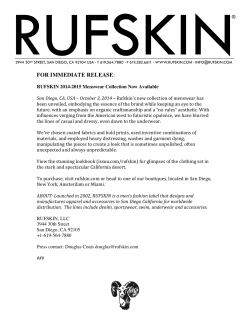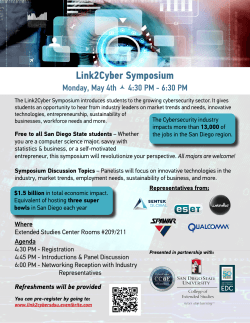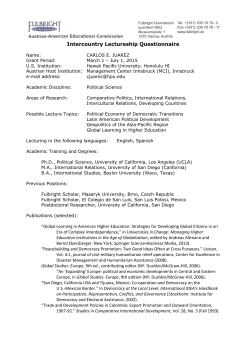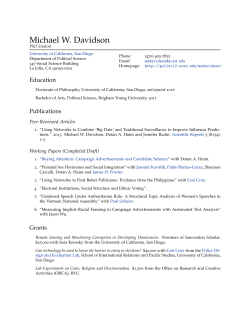
SAN DIEGO BUSINESSJOURNAL - Clean Energy Works For Us
sdbj.com SAN DIEGO BUSINESS JOURNAL THE Volume 36, Number 11 Dining Judy Jones-Cone, owner of Escondido Lexus, traded in the old dealership model for something new and tasty at The Centre. Page 10 COMMUNITY OF B U S I N E S S TM Positive Energy Clean Energy and Clean Transportation Jobs Fourth Quarter Top 5 States 2,100 1,081 Commentary JOBS JOBS MICHIGAN NEVADA MISSOURI CALIFORNIA 661 Christian Braemer, of Benefunder, is calling for making changes to the philanthropic business model; it’s time to innovate, disrupt. Page 39 The Lists Life/Health Insurance Agencies Page 18 Property/Casualty Insurance Agencies Page 22 FINANCE: Commercial Sector Opens Up to Small Investments ■ By LOU HIRSH Online crowdfunding has already made its mark in the financing of technology startups, movies and philanthropic giving, and early indications are that it could make its next big splash in the world of commercial real estate investment — led by sites such as Realty Mogul, CrowdStreet and Fundrise. Experts at a recent real estate conference, presented by the Burnham-Moores Center for Real Estate at the University of San Diego, said the crowdfunding model currently plays REAL ESTATE: Health Care, JOBS Other Sectors Seek Out Space TEXAS Source: Environmental Entrepreneurs Crowdfunding Moves Into Real Estate North County Clusters Spur Property Demand JOBS JOBS $2.00 Crowd page 34 600 3,276 March 16-22, 2015 ■ By LOU HIRSH GREEN: State Policies Power Clean-Tech Sector Gains ■ By BRITTANY MEILING C alifornia performed extraordinarily well in the clean energy industry last year, nearly tripling the number of jobs created in the fourth quarter of 2014 compared to the same period of the previous year, according to a recent economic report. This is in stark contrast to the industry as a whole, which took a major blow last year due to ongoing uncertainty about environmental public policy. The quarterly report was published by a business group called Environmental Entrepreneurs, or E2, a group that tracks clean energy and clean transportation jobs and projects in the U.S. E2 reported that California created 3,276 clean energy jobs in the fourth quarter of 2014, up from 1,112 jobs in the same period last year. Growth in North County’s key “cluster” industries — including health care, biotech, clean-tech and sports-related lifestyle companies — is creating jobs, and also raising demand for commercial real estate space. Case in point: The coastal area from Del Mar north to Carlsbad now sports San Diego County’s highest average asking rents for medical office space, according to new data Clean Jobs page 34 North County page 38 Special Report: Insurance & Employment Benefits PAGE 15 Net Neutrality Act: The ‘Fix’ Is In? TECH: Critics Cry Power Grab; Backers Cite Fairness ■ By BRAD GRAVES The federal government’s decision to treat the Internet like a utility is akin to a blockbuster movie that people love or hate. Poway businessman Greg Fadul gives the decision a thumbs down. “The government is fixing a problem that doesn’t exist,” the CEO of Grace Digital said in an email. The net neutrality decision, he said, “has the potential to negatively affect the user’s experience.” It isn’t what you do, but how you do it. — John Wooden The Federal Communications Commission voted 3-2 Feb. 26 to regulate broadband like a utility. The commission said the move would preserve the Internet as a platform for innovation, free expression and economic growth. The decision reflects views expressed by President Obama. The move means that there will not be a “fast lane” for selected Internet traffic and slower passage for everything else. That might start to matter as bandwidth-heavy services, such as streaming video, grow in popularity. Micah Maland, who runs the San Diego office of Foundation Technologies LLC, said he Neutrality page 39 Certified Public Accountants and Financial Advisors phone 858.597.4100 squarmilner.com Page 34 www.sdbj.com SAN DIEGO BUSINESS JOURNAL March 16, 2015 Clean Jobs: Clean Energy and Clean Transportation Jobs and Projects from page 1 Fourth Quarter Top 10 States Policy Supporting Growth Jason Anderson, president and CEO of the industry trade group Cleantech San Diego, said the region’s competiveness stems from a suite of policies and programs that bolstered the clean energy industry, including the California Global Warming Solutions Act (Assembly Bill 32). AB 32 was signed into law in 2006 by then Gov. Arnold Schwarzenegger. The law sought to fight climate change through a program that would reduce greenhouse gas emissions from virtually all sources statewide. The act required the California Air Resources Board to develop regulations and market mechanisms that would cut the state’s emissions by 25 percent by 2020. The state also embraced an ambitious Renewables Portfolio Standard and numerous municipal financing programs to advance energy efficiency, solar, biofuel and wind generation. “With the regulatory framework that we have in California, we’ve created a market certainty here in the state which is why our sector continues to grow,” Anderson said. “Other states and the federal government haven’t passed legislation or policy to the level that California has.” California | 3,276 Jobs - 7 Projects San Diego County Solar Systems Inc. One of the nation’s largest solar projects is housed at the University of California, San Diego, where a massive micro grid powers the campus of 45,000 people and 450 buildings. The system generates 92 percent of the campus’s electricity and saves the university about $850,000 a month in savings compared with buying retail energy, said Byron Washom, UC San Diego’s director of strategic energy initiatives. Outside of solar, San Diego is steeped in clean energy projects ranging from sustainability initiatives at the Port of San Diego and San Diego International Airport to city and county “smart city” programs meant to cut down on greenhouse gas emissions and increase energy efficiency. San Diego is home to powerhouse bioreneweables companies like Sapphire Energy, Cellana and Synthetic Genomics, and the algae industry generated 1,020 jobs in the San Diego region in 2013, according to Sandag. a small but growing role in capital-raising for purchases of properties such as offices, apartments and hotels. One high-profile Southern California example was the move last year by Kittridge Hotels & Resorts LLC to sell a 15 percent share of ownership in the Hard Rock Hotel Palm Springs — worth more than $1.5 million — to 85 investors located throughout the country via the website of Beverly Hills-based Realty Mogul. Lewis Feldman, a Los Angeles partner in the law firm Goodwin Procter LLP, told the USD audience that based Lewis Feldman on current growth trends, crowdfunding for all types of investments is on track to surpass $20 billion nationwide in 2016, and various entities have projected that the portion focused on real estate could reach $2.5 billion by the end of 2015. for building trust in the platforms. “‘Compliance, compliance’ will be the new version of ‘location, location,’ ” Feldman said. Real estate crowdfunding was enabled in part by provisions of the federal Jumpstart Our Business Startups (JOBS) Act of 2012, intended to lighten restrictions on the ability of small companies to raise equity. However, under rules enforced by the Securities and Exchange Commission, investors in such transactions must have annual income of more than $200,000 or a net worth higher than $1 million. The crowdfunding sites enable qualified investors to buy shares in specific buildings and projects, which is different from traditional investment vehicles such as real estate investment trusts, which sell shares in entire property portfolios. Crowdfunding investors typically are able to share in rents and other revenues generated by properties, as well as profits gained when the properties are sold. The websites take fees from sellers and investors for acting as middlemen, and allow users to invest sums as little as $100 in properties, with the average investments reported by the sites ranging from $10,000 to $50,000. How it Works Who Will Invest modest-sized real estate deals, with lesser impact on larger investments made by institutional entities. “I suspect it is more suited to multifamily since that has less complicated leasing and average investors can better relate to the demand-supply fundamentals,” Miller said in an email following the USD conference, Norm Miller where he moderated the session on crowdfunding. “It’s more transparent, although management still matters and that requires more due diligence than typical crowdfunders can reveal,” Miller said. He added that the growth of crowdfunding in real estate will hinge partly on whether federal regulators eventually allow smaller investors into the game — what the crowdfunding community has referred to as “the democratization of ownership.” According to the industry website Crowdsourcing.org, total money raised through sites geared to all types of fundraising grew from $2.7 billion in 2012 to $5.1 billion in 2013, with $10 billion projected for full-year 2014. The Wall Street Journal calculated that only a small portion of total crowdfunding dollars — approximately $135 million in debt and equity — had been raised for U.S. real estate property transaction E2 tracked more than 4,400 new jobs from California’s solar sector in 2014, as residential installers opened new offices and utilities announced large-scale projects in the state. Anderson said the San Diego metro area is a solar energy hub, leading the nation in solar installations per capita. “The installation of solar rooftops is likely our biggest job creator,” Anderson said. “There are 54,000 solar workers in California and close to 11,570 in Southern California alone.” The county is home to a number of solar companies, including Sullivan Solar Power, Baker Electric Solar and Borrego Crowd: from page 1 A key factor will be moves by the crowdfunding sites to properly screen investments being presented, as well as the investors seeking to partake in deals, which is crucial Michigan | 2,100 Jobs - 2 Projects Nevada | 1,081 Jobs - 3 Projects Texas | 661 Jobs - 6 Projects Missouri | 600 Jobs - 1 Projects Wisconsin | 313 Jobs - 3 Projects 2013 2014 JOBS 78,000 PROJECTS 260 47,000 170 New Mexico | 300 Jobs - 1 Projects Iowa | 296 Jobs - 2 Projects Indiana | 275 Jobs - 3 Projects Minnesota | 275 Jobs - 3 Projects Source: Environmental Entrepreneurs 0 500 1,000 Norm Miller, a real estate professor at USD’s School of Business Administration, said crowdfunding in a few years could have a noticeable impact on small- to 1,500 2,000 Clean Energy Industry News for the rest of the country’s clean energy industry is less inspiring. Only 47,000 clean energy jobs at 170 projects were announced nationally in 2014, down from 78,000 jobs at 260 projects in 2013, according to E2’s report. “Despite the continued growth, on- 2,500 3,000 3,500 going uncertainty over public policy at both the federal and state levels, coupled with the expiration of beneficial tax policies, continued to cast a cloud over clean energy industries, resulting in fewer announcements than in the past,” the E2 report said. Anderson said San Diego’s local industry can stay competitive by paying attention to state-level policy. “We have to continue to advocate for policies that help drive the market,” Anderson said. “It’s important for the business community to be aware of what’s happening at the state level in Sacramento, and how it impacts the potential growth of this industry.” CROWDFUNDING NUMBERS $10 billion: U.S. crowdfunding investments, 2014. $20 billion: Projected crowdfunding investments, 2016. $135 million: U.S. real estate crowdfund deals, mid-2014. $2.5 billion: Projected real estate crowdfund deals, year-end 2015. Sources: Crowdsourcing.org, Wall Street Journal, Forbes, Bloomberg as of mid-2014. Ian Formigle, vice president of investments for Portland, Ore.-based CrowdStreet Inc., told the USD conference audience that his online sector can currently be compared to “retail circa 1997.” Investors are in the early stages of accepting websites as Ian Formigle places to make real estate deals, similar to the way online stock and fund trading was gradually adopted by consumers a decade ago. Formigle said the platforms are helping educated investors with realistic expectations make decisions on a broad array of investments within a relatively short time span.
© Copyright 2025














